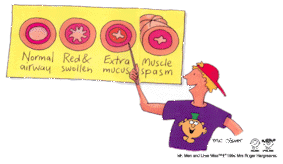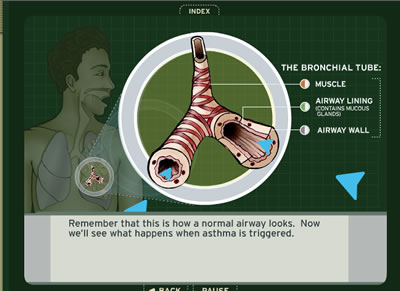Asthma
From Pdhpe Magdalene
(Difference between revisions)
| (14 intermediate revisions not shown) | |||
| Line 1: | Line 1: | ||
| + | [[http://editthis.info/pdhpe_magdalene/Year12PDHPE Year 12 PDHPE]] | ||
| + | |||
'''Asthma''' | '''Asthma''' | ||
| - | + | [http://www.whatsasthma.org/ http://editthis.info/images/pdhpe_magdalene/6/6b/Asthma.jpg] | |
| - | + | Click the above image to see an animated overview of asthma - http://www.whatsasthma.org/ | |
'''Nature of the problem.''' | '''Nature of the problem.''' | ||
| Line 11: | Line 13: | ||
* the muscles around the airways tighten. | * the muscles around the airways tighten. | ||
* increased mucus secretion partially blocks the airways. | * increased mucus secretion partially blocks the airways. | ||
| + | |||
| + | http://editthis.info/images/pdhpe_magdalene/0/09/Pic1-1.gif | ||
| + | image from http://www.asthmaaustralia.org.au/ | ||
'''Extent of the problem''' | '''Extent of the problem''' | ||
| Line 22: | Line 27: | ||
'''Risk factors''' | '''Risk factors''' | ||
| + | |||
Non-modifiable | Non-modifiable | ||
| - | + | * Age | |
| - | + | * Gender | |
| - | + | * Family history | |
| - | + | Modifiable | |
| - | + | * Irritants (smoke, pollution, deodorant) | |
| - | + | * allergens (pollen, dust, mould spores) | |
| - | + | * Viral infections | |
| - | + | * exercise | |
| - | + | * weather changes(cold air) | |
| - | + | * food preservatives | |
'''Social determinants''' | '''Social determinants''' | ||
| - | + | * Low SES are more likely to work in environments with irritants (pollution, chemicals) | |
| - | + | * Low SES are more likely to smoke, and their children who passive smoke are more likely to develop asthma | |
| - | + | * Low SES generally have less access to heath services to manage and treat their asthma. | |
| - | + | * Rural and remote areas have limited access to emergency care. | |
Current revision as of 10:36, 18 December 2007
Asthma
Click the above image to see an animated overview of asthma - http://www.whatsasthma.org/
Nature of the problem.
Asthma is a respiratory disease where the narrowing of a person's airways causes difficulty in breathing. This happens because;
- the inside lining of the airways becomes swollen.
- the muscles around the airways tighten.
- increased mucus secretion partially blocks the airways.
 image from http://www.asthmaaustralia.org.au/
image from http://www.asthmaaustralia.org.au/
Extent of the problem
- Mortality rates have decreased over the last 10 years.
- self reported prevalence has increased over the past 10 years.
- Asthma is he most common reason for hospital admission of children.
- Prevalence is highest amongst people aged 4-25.
- Death rate is highest in rural and remote areas - possibly due to limited access to emergency care.
- Indiginous Australians have a higher prevalence of asthma.
- Boys have a higher rate up until teenage years, Girls have a higher rate after the teenage years.
Risk factors
Non-modifiable
- Age
- Gender
- Family history
Modifiable
- Irritants (smoke, pollution, deodorant)
- allergens (pollen, dust, mould spores)
- Viral infections
- exercise
- weather changes(cold air)
- food preservatives
Social determinants
- Low SES are more likely to work in environments with irritants (pollution, chemicals)
- Low SES are more likely to smoke, and their children who passive smoke are more likely to develop asthma
- Low SES generally have less access to heath services to manage and treat their asthma.
- Rural and remote areas have limited access to emergency care.

